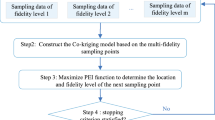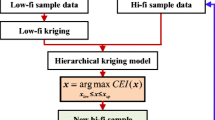Abstract
This paper deals with variable-fidelity optimization, a technique in which the advantages of high- and low-fidelity models are used in an optimization process. The high-fidelity model provides solution accuracy while the low-fidelity model reduces the computational cost.
An outline of the theory of the Approximation Management Framework (AMF) proposed by Alexandrov (1996) and Lewis (1996) is given. The AMF algorithm provides the mathematical robustness required for variable-fidelity optimization.
This paper introduces a subproblem formulation adapted to a modular implementation of the AMF. Also, we propose two types of second-order corrections (additive and multiplicative) which serve to build the approximation of the high-fidelity model based on the low-fidelity one.
Results for a transonic airfoil shape optimization problem are presented. Application of a variable-fidelity algorithm leads to a threefold savings in high-fidelity solver calls, compared to a direct optimization using the high-fidelity solver only. However, premature stops of the algorithm are observed in some cases.
A study of the influence of the numerical noise of solvers on robustness deficiency is presented. The study shows that numerical noise artificially introduced into an analytical function causes premature stops of the AMF. Numerical noise observed with our CFD solvers is therefore strongly suspected to be the cause of the robustness problems encountered.
Similar content being viewed by others
References
Alexandrov NM (1996) Robustness properties of a trust region framework for managing approximations in engineering optimization. In: 6th AIAA/NASA/USAF/ISSMO symp on multidisciplinary analysis and optimization, AIAA 1996–4102, Bellevue, WA
Alexandrov NM (1998) On managing the use of surrogates in general nonlinear optimization and MDO. In: 7th AIAA/NASA/USAF/ISSMO symp on multidisciplinary analysis and optimization. AIAA 1998–4798, St. Louis, MO
Alexandrov NM, Dennis JE Jr, Lewis RM, Torczon V (1997) A trust region framework for managing the use of approximation models in optimization. ICASE, Technical Report 97-50
Alexandrov NM, Lewis RM, Gumbert CR, Green LL, Newman PA (2000) Optimization with variable-fidelity models applied to wing design. In: AIAA 38th aerospace sciences meeting and exhibit. AIAA 2000–0841, Reno, NV
Alexandrov NM, Nielsen EJ, Lewis RM, Anderson WK (2000) First-order model management with variable-fidelity physics applied to multi-element airfoil optimization. In: 8th AIAA/NASA/USAF/ISSMO symp on multidisciplinary analysis and optimization. AIAA 2000–4886, Long Beach, CA
Alexandrov NM, Lewis RM (2000) First-order frameworks for managing models in engineering optimization. In: 1st Int workshop on surrogate modelling and space mapping for engineering optimization. Lyngby, Denmark
Alexandrov NM, Lewis RM, Gumbert CR, Green LL, Newman PA (2001) Approximation and model management in aerodynamic optimization with variable-fidelity models. J Aircraft 38(6):1093–1101
Barthelemy J-FM, Haftka RT (1993) Approximation concepts for optimal structural design. Struct Optim 5(3):129–144
Bauer F, Garabedian P, Korn D (1977) Supercritical wing section 3, Springer-Verlag, Berlin, Germany
Chang KJ, Haftka RT, Giles GL, Kao PJ (1993) Sensitivity-based scaling for approximating structural response. J Aircraft 30:283–288
Conn AR, Gould NIM, Toint PL (2000) Trust-region methods. MPS/SIAM series on optimization, SIAM, Philadelphia, PA
Dennis JE Jr, Schnabel RB (1983) Numerical methods for unconstrained optimization and nonlinear equations. Prentice-Hall, Englewood Cliffs, NJ
Dennis JE Jr, Torczon V (1995) Managing approximation models in optimization. In: Multidisciplinary design optimization—state-of-the-art, Proceedings of the ICASE/NASA langley workshop on multidisciplinary design optimization, Hampton, VA
Egorov IN, Kretinin GV, Leshchenko IA, Kuptzov SV (2002) IOSO optimization toolkit—novel software to create better design. In: 9th AIAA/ISSMO symposium on multidisciplinary analysis and optimization. AIAA 2002–5514, Atlanta, GA
Gay DM (1982) On convergence testing in model/trust-region algorithms for unconstrained optimization. Compu. Sci. Techn. Report 104, Bell Laboratories
Haftka RT (1991) Combining global and local approximations. AIAA J 29(9):1523–1525
Lépine J, Guibault F, Trépanier J-Y, Pépin F (2001) Optimized nonuniform rational B-spline geometrical representation for aerodynamic design of wings. AIAA J 39(11):2033–2041
Lewis RM (1996) A trust region framework for managing approximation models in engineering optimization. In: 6th AIAA/NASA/USAF/ISSMO symp on multidisciplinary analysis and optimization. AIAA 1996–4101, Bellevue, WA
Lewis RM, Nash SG (2000) A multigrid approach to the optimization of systems governed by differential equations. In: 8th AIAA/NASA/USAF/ISSMO symp on multidisciplinary analysis and optimization. AIAA 2000–4890, Long Beach, CA
Marduel X (2002) Optimisation à fidelité variable, Master’s thesis, École polytechnique de Montréal
Marduel X, Tribes C, Trépanier J-Y (2002) Optimization using variable fidelity solvers: exploration of an approximation management framework for aerodynamic shape optimization. In: 9th AIAA/ISSMO symp on multidisciplinary analysis and optimization. AIAA 2002–5595, Atlanta, GA
Mavriplis DJ (1996) A CFD package for multi-element airfoil high-lift analysis. Scientific Simulation, Yorktown, VA
Mohammadi B (1994) Fluid dynamics computation with NSC2KE, an user-guide, Release 1.0. Technical Report RT-0164, Institut National de Recherche en Informatique et en Automatique, France
Mohammadi B, Pironneau O (1994) Analysis of the K-epsilon turbulence model. John Wiley & Sons and Masson Ltd, Chichester, UK
Moré JJ (1983) Mathematical programming: the state of the art. Chapt Recent Developments in Algorithms and Software for Trust Region Methods, Springer-Verlag
Powell MJD (1975) Nonlinear programming. 2nd Edn, Chapt convergence Properties of a Class of Minimization Algorithms. Academic Press, New York, pp 1–27
Schmit LA, Farshi B (1974) Some approximation concepts for structural synthesis. AIAA J 12(5):692–699
Schmit LA, Fleury C (1980) Structural synthesis by combining approximation concepts and dual methods. AIAA J 18(10):1252–1260
Schmit LA, Miura H (1976) Approximation concepts for efficient structural synthesis. Technical Report CR-2552, NASA
Spellucci P (1999) DONLP2 Short users guide. Program and user’s guide available as donlp2.tar at ftp://plato.la.asu.edu/pub/donlp2/
Tribes C, Trépanier J-Y (2001) Airfoil shape optimization. In: CSME-MDE, international conference on multidisciplinary design in engineering. Montréal, QC, Canada
Author information
Authors and Affiliations
Corresponding author
Rights and permissions
About this article
Cite this article
Marduel, X., Tribes, C. & Trépanier, JY. Variable-fidelity optimization: Efficiency and robustness. Optim Eng 7, 479–500 (2006). https://doi.org/10.1007/s11081-006-0351-3
Received:
Revised:
Issue Date:
DOI: https://doi.org/10.1007/s11081-006-0351-3




